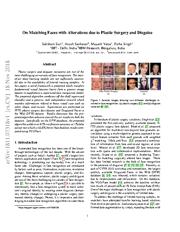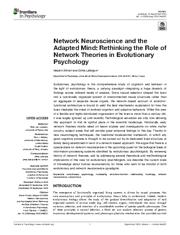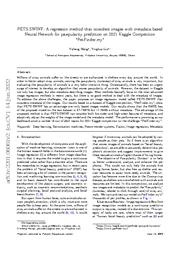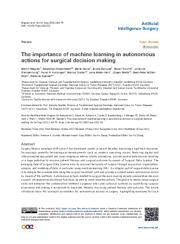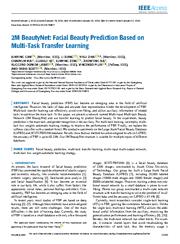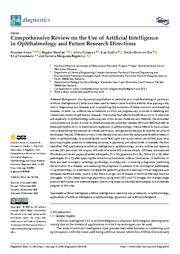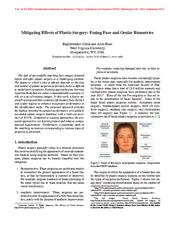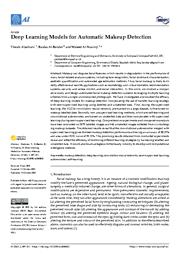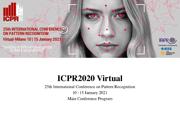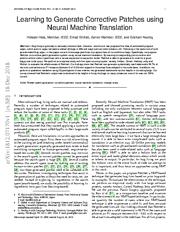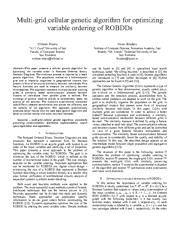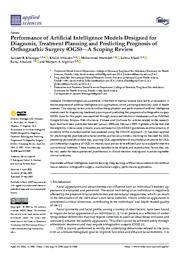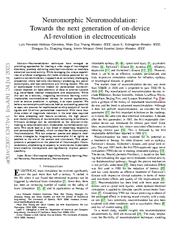A copy of this work was available on the public web and has been preserved in the Wayback Machine. The capture dates from 2020; you can also visit the original URL.
The file type is application/pdf.
Filters
On Matching Faces with Alterations due to Plastic Surgery and Disguise
[article]
2018
arXiv
pre-print
Plastic surgery and disguise variations are two of the most challenging co-variates of face recognition. ...
Experiments are performed on IIITD plastic surgery face dataset and Disguised Faces in the Wild (DFW) dataset. ...
Acknowledgements Vatsa and Singh are partly supported through Infosys Center for Artificial Intelligence at IIIT-Delhi. ...
arXiv:1811.07318v1
fatcat:45mqmty6tvhvflagl3cm6yw7gy
Learning for Meta-Recognition
2012
IEEE Transactions on Information Forensics and Security
In practice, meta-recognition can be implemented in two different ways: a statistical fitting algorithm based on the Extreme Value Theory, and a machine learning algorithm utilizing features computed from ...
In this article, we present a study of the machine learning algorithm and its associated features for the purpose of building a highly accurate meta-recognition system for security and surveillance applications ...
Ross Beveridge, who provided valuable feedback on early drafts of this work. ...
doi:10.1109/tifs.2012.2192430
fatcat:j5azmudesbajzgiic2is4anc3q
Network Neuroscience and the Adapted Mind: Rethinking the Role of Network Theories in Evolutionary Psychology
2020
Frontiers in Psychology
Since natural selection shaped the brain into a functionally organized system of interconnected neural structures rather than an aggregate of separate neural organs, the network-based account of anatomo-functional ...
Historically, early network theories mostly relied on lesion studies and investigations on white matter circuitry, subject areas that still provide great empirical findings to this day. ...
According to this model, face-processing is carried out by a double neural system composed of a core network (i.e., comprising the occipital face and fusiform face areas, as well as the posterior part ...
doi:10.3389/fpsyg.2020.545632
pmid:33101120
pmcid:PMC7545950
fatcat:7idrahc7znhh7h425yqas6cusi
PETS-SWINF: A regression method that considers images with metadata based Neural Network for pawpularity prediction on 2021 Kaggle Competition "PetFinder.my"
[article]
2022
arXiv
pre-print
Our results based on a dataset of Kaggle competition, "PetFinder.my", show that PETS-SWINF has an advantage over only based images models. ...
The advantage of the proposed method is that PETS-SWINF can consider both low-order and high-order features of metadata, and adaptively adjust the weights of the image model and the metadata model. ...
Acknowledgements The proposed method was inspired by Professor Zhu and Professor Tang in machine learning class 2021. ...
arXiv:2201.06061v2
fatcat:dkwj6mob3vd33poi5xr36mkhh4
The importance of machine learning in autonomous actions for surgical decision making
2022
Artificial Intelligence Surgery
The emerging field of Surgical Data Science aims to improve the quality of surgery through acquisition, organization, analysis, and modeling of data, in particular using machine learning (ML). ...
Surgery faces a paradigm shift since it has developed rapidly in recent decades, becoming a high-tech discipline. ...
Increasing the depth of a neural network can learn more complex features and model more complex problems. ...
doi:10.20517/ais.2022.02
fatcat:462tf4p4mbgvxlbvot43hadxwe
2M BeautyNet: Facial Beauty Prediction Based on Multi-Task Transfer Learning
2020
IEEE Access
In this paper, we present a network named Multi-input Multi-task Beauty Network (2M BeautyNet) and use transfer learning to predict facial beauty. ...
However, the lacks of data and accurate face representation hinder the development of FBP. ...
surgery planning [2] , face-based pose analysis [3] and facial beautification [4] . ...
doi:10.1109/access.2020.2968837
fatcat:ffyfh2pz5rfhxooely5p6jyefu
Comprehensive Review on the Use of Artificial Intelligence in Ophthalmology and Future Research Directions
2022
Diagnostics
AI tools, i.e., artificial neural networks (ANNs), are progressively involved in detecting and customized control of ophthalmic diseases. ...
Neural networks have a major role in establishing the demand to initiate preliminary anti-glaucoma therapy to stop the advance of the disease. ...
Modeling based on neural networks consists of rendering the dependence between the output and input variables [3, 5] . ...
doi:10.3390/diagnostics13010100
pmid:36611392
pmcid:PMC9818832
fatcat:fefhludlynbb7o3xhw5qhsgd2y
Mitigating effects of plastic surgery: Fusing face and ocular biometrics
2012
2012 IEEE Fifth International Conference on Biometrics: Theory, Applications and Systems (BTAS)
The degree to which a face is altered depends on the type and number of plastic surgeries performed, and it is difficult to model such variations. ...
The task of successfully matching face images obtained before and after plastic surgery is a challenging problem. ...
Vinod Kulathumani and Sriram Sankar at West Virginia University for their support in using the PittPatt software. They are grateful to Dr. Mayank Vatsa, Dr. Richa Singh, and Himanshu S. ...
doi:10.1109/btas.2012.6374607
dblp:conf/btas/JillelaR12
fatcat:uiyuusnjvfahrnbfqbah7k3ze4
Emerging Biometrics: Deep Inference and Other Computational Intelligence
[article]
2020
arXiv
pre-print
This paper aims at identifying emerging computational intelligence trends for the design and modeling of complex biometric-enabled infrastructure and systems. ...
Biometric-enabled systems are evolving towards deep learning and deep inference using the principles of adaptive computing, - the front tides of the modern computational intelligence domain. ...
Acknowledgment This project was partially supported by Natural Sciences and Engineering Research Council of Canada (NSERC) through the grant "Biometric intelligent interfaces". ...
arXiv:2006.11971v1
fatcat:k6aunuoxc5apbb347vy2lj7bsq
Deep Learning Models for Automatic Makeup Detection
2021
AI
First, during the supervised learning, the VGG16 convolution neural network, pre-trained on a large dataset, is fine-tuned on makeup labelled data. ...
We have investigated and studied the efficacy of deep learning models for makeup detection incorporating the use of transfer learning strategy with semi-supervised learning using labelled and unlabelled ...
Many semisupervised learning with deep neural networks were designed based on generative models such as denoising auto-encoders [19] , stacked convolutional auto-encoders [20] , variational auto-encoders ...
doi:10.3390/ai2040031
doaj:23804649723344e88e534b0a7537bbf9
fatcat:jwlbcgfhlncbfd4dxxce2ahmku
Learning Neural Textual Representations for Citation Recommendation
2021
2020 25th International Conference on Pattern Recognition (ICPR)
, Zhongfei
43
Is the Meta-Learning Idea Able to Improve the Generalization of
Deep Neural Networks on the Standard Supervised Learning? ...
Heat Map Based Pose
Estimation
DAY 4 -Jan 15, 2021
Wu, Fangyu; Smith, Jeremy Simon;
Lu, Wenjin; Zhang, Bailing
2388
Pose-robust Face Recognition by Deep Meta Capsule network-based
Equivariant ...
doi:10.1109/icpr48806.2021.9412725
fatcat:3vge2tpd2zf7jcv5btcixnaikm
Learning to Generate Corrective Patches using Neural Machine Translation
[article]
2019
arXiv
pre-print
By learning corresponding pre-correction and post-correction code in past fixes with a neural sequence-to-sequence model, Ratchet is able to generate a fix code for a given bug-prone code query. ...
Our findings show that Ratchet can generate syntactically valid statements 98.7% of the time, and achieve an F1-measure between 0.29 - 0.83 with respect to the actual fixes adopted in the code base. ...
BACKGROUND Neural machine translation, also called neural sequence-tosequence models [53] , [54] , [55] is a method for converting one input sequence x into another output sequence y using neural networks ...
arXiv:1812.07170v2
fatcat:i6goyuglwbbvpiapgu7r5ls6re
Multi-grid cellular genetic algorithm for optimizing variable ordering of ROBDDs
2012
2012 IEEE Congress on Evolutionary Computation
The population evolves on a bidimensional grid and is implicitly organized in geographical clusters that present a form of structural similarity between individuals. ...
The extensive experimental evaluation uses difficult classical benchmarks and proves the efficiency and the stability of the algorithm. ...
BCM Theory of Meta-Plasticity 676, Nikolaos Kourentzes, Data Driven Fitting Sample Selection For Time Series Forecasting With Neural Networks Tuesday, IJCNN, TuN 5-3, 16:10-17:10, Spiking Neural Networks ...
doi:10.1109/cec.2012.6256590
dblp:conf/cec/RotaruB12
fatcat:4ly3nrktw5habc6lf5err7d5py
Performance of Artificial Intelligence Models Designed for Diagnosis, Treatment Planning and Predicting Prognosis of Orthognathic Surgery (OGS)—A Scoping Review
2022
Applied Sciences
This scoping review aims to outline the application and performance of artificial intelligence models used for diagnosing, treatment planning and predicting the prognosis of orthognathic surgery (OGS). ...
Eighteen articles that met the eligibility criteria were critically analyzed based on QUADAS-2 guidelines and the certainty of evidence of the included studies was assessed using the GRADE approach. ...
The application of AI models in OGS are mostly based on machine learning and deep learning architecture. These models learn the deep features for image recognition after being trained by data sets. ...
doi:10.3390/app12115581
fatcat:q5l6dn36xzgqdjjvlxm5vj72nu
Neuromorphic Neuromodulation: Towards the next generation of on-device AI-revolution in electroceuticals
[article]
2023
arXiv
pre-print
The use of sophisticated AI-driven models for personalized neurostimulation depends on back-telemetry of data to external systems (e.g. cloud-based medical mesosystems and ecosystems). ...
We believe neuromorphic architectures hold an outstanding potential to open new avenues for sophisticated on-chip analysis of neural signals and AI-driven personalized treatments. ...
A novel, bio-inspired strategy to mitigate catastrophic forgetting and to continue learning, is synaptic meta-plasticity [116] . ...
arXiv:2307.12471v2
fatcat:oqyupvk5vjgjdd4z4rr7ggqf7q
« Previous
Showing results 1 — 15 out of 1,755 results

